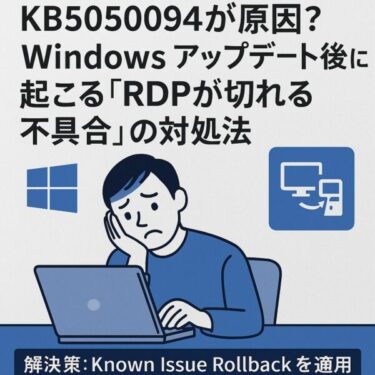※ While most modern computers use UEFI (the successor to BIOS), this article uses the term “BIOS” for simplicity and ease of understanding.
![How to Fix Windows Error Code 0xc000000f: A Step-by-Step Recovery Guide for Beginners [2025 Edition] 1 A person looks worried while sitting in front of a laptop showing the Windows error code 0xc000000f on a dark blue screen, with the text "Windows Recovery" and "Fixing Boot Error" displayed above and below.](https://kimiyoya.com/wp-content/uploads/2025/07/B7A5E24F-A64B-492E-A2B2-43F0FB209456-300x300.jpg)
“Wait… it was working fine just a moment ago!” Have you ever been in this situation—where your Windows PC suddenly refuses to boot and shows a mysterious error code like 0xc000000f? You’re not alone.
This error can be terrifying, especially when you’re faced with a black screen filled with unfamiliar words like “Boot Configuration Data.” But don’t worry—this guide will walk you through what the error means, why it happens, and how to fix it, step by step.
What Is Error Code 0xc000000f?
Error 0xc000000f means that Windows can’t find or read the files it needs to start properly. In most cases, this points to corruption in the Boot Configuration Data (BCD).
Common causes include:
• Sudden power outages or forced shutdowns
• Interrupted Windows Update
• Disk or cable errors
• Incorrect BIOS boot order or settings
To fix this issue, you’ll need a USB recovery drive or a Windows installation media.
How to Fix Error 0xc000000f (Beginner-Friendly Steps)
① Boot from a USB Recovery Drive
If you already have a recovery USB, insert it into your PC and follow these steps:
• Turn off your PC completely
• Plug in the USB drive
• Turn the PC back on, and immediately press F2, F12, Delete or Esc to enter BIOS (the key depends on your computer’s brand)
• Change the boot order so that the USB is the first boot device
• Save and exit BIOS—your PC should now boot from the USB
② Open Command Prompt from Recovery Options
Once the system boots from the USB, do the following:
• On the Windows setup screen, select your language and click “Next”
• Click on “Repair your computer” (bottom-left corner)
• Choose “Troubleshoot” → “Advanced options” → “Command Prompt”
③ Run Bootrec Commands to Repair Boot Data
In the Command Prompt, type the following commands one by one, pressing Enter after each:
bootrec /fixmbrbootrec /fixbootbootrec /scanosbootrec /rebuildbcdWhat each command does:
• /fixmbr: Repairs the Master Boot Record
• /fixboot: Writes a new boot sector
• /scanos: Scans your drives for Windows installations
• /rebuildbcd: Rebuilds the Boot Configuration Data
When finished, close the Command Prompt and restart your PC.
⚠️ Advanced Option: Manually Delete and Rebuild BCD
If bootrec commands don’t work, try deleting and rebuilding the BCD manually (use with caution):
attrib c:\boot\bcd -h -r -sdel c:\boot\bcdbootrec /rebuildbcdOnly do this if you’re comfortable using the command line. A wrong step here can make the system unbootable.
💽 No USB Recovery Drive? Here’s What to Do
You can create one using another Windows PC:
• Visit Microsoft’s official page to download the Media Creation Tool
• Prepare an 8GB or larger USB flash drive
• Follow the instructions to create a Windows 10 or 11 bootable USB
Extra Recovery Options
Still not working? Try these tools from the same recovery screen:
Startup Repair
From “Advanced Options,” select “Startup Repair,” choose your OS, and let Windows automatically detect and fix startup problems.
Run chkdsk (Check Disk)
In Command Prompt, run:
chkdsk C: /f /rC: is usually the drive where Windows is installed. If it doesn’t work, try D: or E:. Once you’ve entered the correct drive letter, just press Enter to begin the scan.
⚠️ This process can take 30 minutes or more. Be patient and don’t interrupt it.
Memory Check (RAM)
Type mdsched.exe in the Start Menu → Choose “Restart now and check for problems.”
Your PC will restart and run a memory test. Results appear after reboot.
BIOS Reset to Defaults
Enter BIOS (F2 or Delete), find “Load Defaults” or “Restore Settings,” confirm, then choose “Save & Exit.”
This often solves boot order or setting issues.
Can’t Boot but Need Your Files? Try This.
If you need to recover important files before fixing Windows:
• Use a Linux Live USB (like Ubuntu) to access the drive
• Or remove the hard drive and connect it to another PC using a SATA-to-USB adapter
• Or consult a data recovery service (costly, but effective if data is critical)
❓ FAQ: Common Questions
Q: Can restarting fix it?
A: Sometimes, yes. Temporary issues may disappear with a reboot. But repeated failures usually mean boot data or disk issues.
Q: How can I tell if it’s a hardware or software problem?
A: If the error happens randomly or at startup, it might be hardware (RAM, SSD, cables).
If it only happens after launching a program, it’s likely software.
Q: Is this dangerous to try?
A: No, as long as you follow the instructions and avoid formatting or deleting the wrong partitions.
Summary: Stay Calm and Step Forward
Error 0xc000000f may seem scary, but in most cases, it can be fixed without losing your data. With a recovery USB and some patience, many users successfully repair their systems at home.
If you ever feel unsure, it’s okay to ask a professional or use Microsoft’s support. And don’t forget: regular backups can save your future self a lot of stress!
We hope this guide helped you get your PC back on track. If so, consider bookmarking it—you never know when Windows might surprise you again!
✔️You might also find these helpful:
▶︎Office Not Opening or Crashing After Windows Update?
▶︎Realtek Audio Device Not Showing on Windows 11? Here’s How to Fix It (2025 Edition)
💡 Looking for more tips? Check out our full list of Windows Help Guides.


